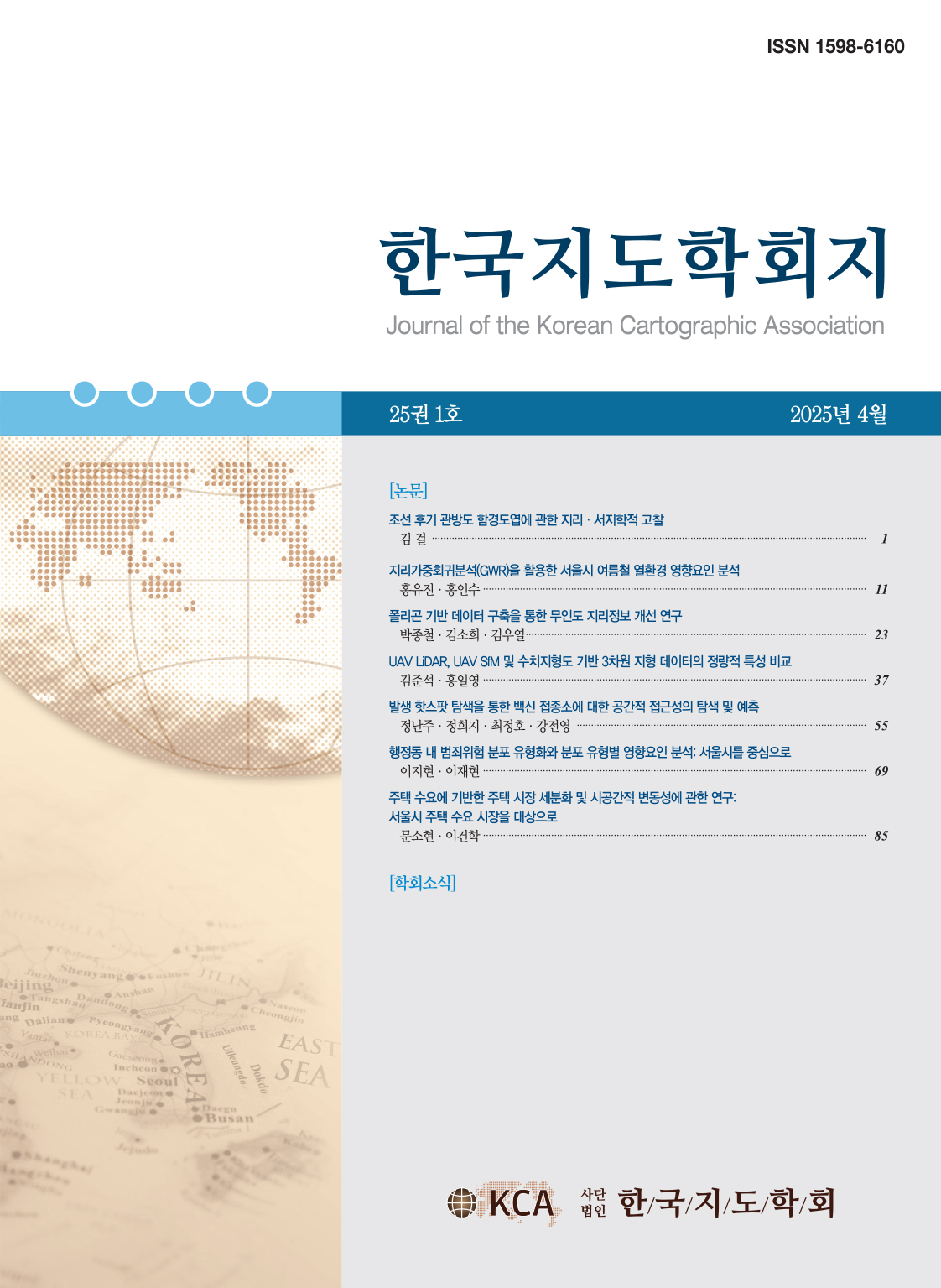Research Article
Abstract
References
Information
This study predicted the distribution of risk areas for pine wilt disease (PWD) based on machine learning by using 15 environmental variables. The maximum entropy model was employed for the study and AUC (area under the curve) was used to evaluate the model. The study area is Gyeongju, and the study period is 2018-2020. In the study area, the core distribution area of trees infected with PWD expanded 2.5 times and 4.7 times in 2019 and 2020 compared to 2018, respectively. The AUC of the spatial estimation for PWD was at least 0.86 in each year. The most important variable in the model was the proximity of infected trees in the previous year. The topography, proximity to roads and wooden buildings, and the average temperature in May were also important variables. It means that human activities and the environment of its vectors play an important role in the spatial distribution of PWD. Furthermore, the results of the study suggest that the establishment and sharing of the distribution data for infected trees are important for policies and research for the prevention of PWD.
본 연구는 머신러닝 기법을 토대로 15개 환경 변수를 활용하여 소나무재선충병의 위험지역 분포를 예측하였다. 연구는 최대 엔트로피 모델을 머신러닝 기법으로 활용하였고, 연구 지역은 경주이며 연구 기간은 2018∼2020년이다. 모델의 평가에는 AUC(area under the curve)를 이용하였다. 연구 지역에서 소나무재선충병의 감염목 핵심 분포 지역은 2018년 대비 2019년과 2020년에 각각 2.5배와 4.7배 확대되었다. 소나무재선충병의 감염목 분포 추정 모델의 AUC는 모든 해에 최소 0.86 이상이었다. 모델에서 가장 중요한 변수는 직전 해의 감염목 근접도 이었다. 지형과 도로와의 인접성, 목조건물 인접성, 5월 평균 기온도 중요한 변수이었다. 인간 활동과 매개충의 생장 환경이 소나무재선충병의 공간적 분포에 중요한 역할을 한다는 것을 의미한다. 나아가 연구의 결과는 감염목 분포 정보의 지속적인 구축과 공유가 소나무재선충병 예방을 위한 정책과 연구에 중요하다는 것을 시사한다.
- 경주신문, 2017년 05월 18일, "재선충의 개념과 원인, 그리고 경주의 실태-재선충병 경주 산림을 위협한다!"
- 국가공간정보포털, "임상도(1:5000)", 임상도(5000) 속성정보, http://www.nsdi.go.kr/lxdownload/download.do? DS_SQ=20190716DS00001&FILE_SQ=188716 (2021. 12 검색)
- 김근한・김오석・윤정호, 2019, "공간 DBMS 기반의 국토환경성평가지도를 활용한 도시 확장 예측," 한국지도학회지, 19(3), 35-42. 10.16879/jkca.2019.19.3.035
- 김동우・박종철・장동호, 2017, "표준강수지수와 정규식생지수를 활용한 봄 가뭄 탐지 가능성 분석," 한국지리학회지, 6(2), 165-174. http://dx.doi.org/10.25202/JAKG.6.2.5 10.25202/JAKG.6.2.5
- 김영호・김광진・이수진・김지원・이양원, 2017, "딥러닝을 이용한 남한 500m 해상도의 일단위 토양수분 산출," 한국지도학회지, 17(3), 109-121. http://dx.doi.org/10.16879/jkca.2017.17.3.109 10.16879/jkca.2017.17.3.109
- 김종원, 2006, "소나무재선충 발생현황과 예방대책에 대한 생태학적 접근," 경북발전 연구 논문집, V, 182-224.
- 김지연・서창완・권혁수・류지은・김명진, 2012, "전국자연환경조사 자료를 이용한 종분포모형 연구," 환경영향평가, 21(4), 593-607. 10.14249/eia.2012.21.4.593
- 박종철・김만규, 2016, "PRISM-KNU의 개발과 남한 월강수량 분포도 작성," 한국지리정보학회지, 19(2), 27-46. 10.11108/kagis.2016.19.2.027
- 박종철・김장수, 2014, "2009년 국가토지피복도와 통계연보의 지목 자료를 활용한 2000년 토지피복별 면적 추정 방법," 한국지도학회지, 14(2), 27-38. http://dx.doi.org/10.16879/jkca.2014.14.2.027 10.16879/jkca.2014.14.2.027
- 박종철・정일원・장희준・김만규, 2012, "남한 강수량 분포 추정을 위한 PRISM 매개변수 및 수치표고모형 최적화," 한국지리정보학회지, 16(3), 147-163. 10.11108/KAGIS.2016.19.2.027
- 박종철・최광준・송성호, 2014, "미래(2015∼2044년) 기후변화에 따른 제주도의 사면과 해발고도별 가뭄 예측," 한국환경과학회지, 23(4), 649-660. http://dx.doi.org/10.5322/JESI.2014.4.649 10.5322/JESI.2014.4.649
- 산림청, 2015, 「소나무재선충병 방제지침」, 5.
- 산림청, 2020, 「산림기본통계 : 1. 소유별 산림면적・임목축적」, 218.
- 산림청, 2021a, 「임업통계연보 : III. 산림의 건강 및 다양한」, 3-2장.
- 산림청, 2021b, 「2021년도 산림병해충 예찰・방제 계획」, 19.
- 서창완・박유리・최윤수, 2008, "위차자료의 종류에 따른 생물종 분포모형 비교 연구," 대한공간정보학회지, 16(4), 59-64.
- 알-마문・장동호・박종철, 2017, "산사태 분포 예측 위한 로지스틱, 베이지안, Maxent의 비교," 한국지형학회지, 24(2), 91-101. http://dx.doi.org/10.16968/JKGA. 24.2.91 10.16968/JKGA.24.2.91
- 이대성・남영우・최원일・박영성, 2017, "우리나라에서 소나무재선충병 초기 발생지의 환경 특성 분석," 생태와 환경, 50(4), 374-380. http://dx.doi.org/10.11614/KSL.2017.50.4.374 10.11614/KSL.2017.50.4.374
- 임종서・이건학, 2017, "원격탐사 자료와 지형 기반 공간 보간법을 결합한 도시 기온 추정," 한국지도학회지, 17(2), 75-88. http://dx.doi.org/10.16879/jkca.2017.17.2.075 10.16879/jkca.2017.17.2.075
- 정재준, 2019, "위치정보 활용 측면을 고려한 공공데이터포털의 현황과 발전방안," 한국지도학회지, 19(2), 119-132. 10.16879/jkca.2019.19.2.119
- 한국농촌경제신문, 2018년 10월 2일, "박완주 의원, "소나무재선충병 방제사업 필요예산 현실적으로 조정 필요""
- 홍일영, 2017, "LBSN(Location-Based Social Network) 데이터와 머신러닝 기법을 이용한 토지이용 분류," 한국지도학회지, 17(3), 59-67. http://dx.doi.org/10.16879/jkca.2017.17.3.059 10.16879/jkca.2017.17.3.059
- 한국환경연구원 환경가치종합정보시스템, "가치평가 toolkit", http://evis.kei.re.kr. (2021.12 검색)
- Akema, K. and Futai, K., 2005, Ectomycorrhizal development in a Pinus thunbergii stand in relation to location on a slope and effect on tree mortality from pine wilt disease,
Journal of Forest Research , 10, 93-99. 10.1007/s10310-004-0101-3 - Carvalho, S.B., Goncalves, J., Guisan, A., and Honrado, J.P., 2015, Systematic site selection for multispecies monitoring networks,
Journal of Applied Ecology , 53, 1305-1316. 10.1111/1365-2664.12505 - Collins, M., Schapire, R.E., and Singer, Y., 2002, Logistic regression, AdaBoost and Bregman distances,
Machine Learning , 48, 253-285. 10.1023/A:1013912006537 - Duong, T., 2007, ks: Kernel density estimation and kernel discriminant analysis for multivariate data in R,
Journal of Statistical Software , 21(7). 1-16. 10.18637/jss.v021.i07 - Duong, T., and Hazelton, M.L., 2003, Plug-in bandwidth matrices for bivariate kernel density estimation,
Journal of Nonparametric Statistics , 15, 17-30. 10.1080/10485250306039 - Elith, J., Graham, C.H., Anderson, R.P., Dudik, M., Ferrier, S., Guisan, A., Huettmann, F., Leathwick J.R., Lehmann, A., Li, J., Lohmann, L.G., Loiselle, B.A., Manion, G., Moritz, C., Nakamura, M., Nakazawa, Y., Overton, J.M.M., Peterson, A.T., Phillips, S.J., Richardson, K., Scachetti-Pereira, R., Soberon, J., Williams, S., and Niklaus, M., 2006, Novel methods improve prediction of species' distributions from occurrence data,
Ecography , 29(2), 129-151. 10.1111/j.2006.0906-7590.04596.x - Elith, J., Phillips, S.J., Hastie, T., Dudík, M., Chee, Y.E., and Yates, C.J., 2011, A statistical explanation of MaxEnt for ecologists,
Diversity and Distributions , 17, 43-57. 10.1111/j.1472-4642.2010.00725.x - Franklin, J., 2009, Mapping Species Distributions Spatial Inference and Prediction, Cambridge: Cambridge University Press. 10.1017/CBO9780511810602
- Futai, K., 2008, Pine wilt in Japan: From first incidence to present, in Zhao, B.G., Futai, K., Sutherland, J.R., and Takeuchi, Y. eds.,
Pine Wilt Disease , Tokyo: Springer, 5-12. 10.1007/978-4-431-75655-2_2 - Ha, M.L. and Lee, C.K., 2017, Study on the damage by pine wood nematode in black pine trees,
Journal of Forest and Environmental Science , 33(2), 105-112. 10.7747/JFES.2017.33.2.105 - Hanley, J.A. and McNeil, B.J., 1982, The meaning and use of the area under a receiver operating characteristic (ROC) curve,
Radiology , 143(1), 29-36. 10.1148/radiology.143.1.7063747 - Hashim, M., Ito, S., Numata, S., Hosaka, T., Hossain, M.S., Misbari, S., Nahya, N.N., and Ahmad, S., 2017, Using fisher knowledge, mapping population, habitat suitability and risk for the conservation of dugongs in Johor Straits of Malaysia,
Marine Policy , 78, 18-25. 10.1016/j.marpol.2017.01.002 - Hirata, A., Nakamura, K., Nakao, K., Kominami, Y., Tanaka, N., Ohashi, H., Takano, K.T., Takeuchi, W., and Matsui, T., 2017, Potential distribution of pine wilt disease under future limate change scenarios,
PLoS ONE , 12(8), e0182837. 10.1371/journal.pone.0182837 - Ikeda, T., 1996, Responses of water-stressed Pinus thunbergii to inoculation with avirulent pine wood nematode (Bursaphꠓelenchus xylophilus): Water relations and xylem histology,
Journal of Forest Research , 1(4), 223-226. 10.1007/BF02348329 - Kiyohara, T., Suzuki, K., and Hashimoto, H., 1975, Population dynamics of Bursaphelenchus lignicolus at the early stage after inoculation,
Transactions of the Annual Meeting of the Japanese Forestry Society , 86, 299-300. 10.1303/aez.15.458 - Kwon, T.S., Lim, J.H., Sim, S.J., Kwon, Y.D., Son, S.K., Lee, K.Y., Kim, Y.T., Park, J.W., Shin, C.H., Ryu, S.B., Lee, C.K., Shin, S.C., Chung, Y.J., and Park, Y.S., 2006, Distribution patterns of Monochamus alternatus and M. saltuarius (Coleoptera: Cerambycidae) in Korea,
Journal of Korean Forestry Society , 95(5), 543. - Lee, B.S, Park, J., Seo, J., Song, S.H., and Kim, W., 2019, Delineation of agricultural drought-prone zones considering irrigation capacities of agricultural facilities under climate change,
Paddy and Water Environment , 17, 783-796. 10.1007/s10333-019-00757-8 - Lee, J.H., Cho, K.J., Kim, C.J., and Park, M,J., 2012, Analysis on the spatio-temporal distribution of drought using potential drought hazard map,
Journal of Korea Water Resources Association , 45(10), 983-995. 10.3741/JKWRA.2012.45.10.983 - McKee, T.B., Doesken, N.J., and Kleist, J., 1993, The relationship of drought frequency and duration of tim scale,
8th Conference on Applied Climatology , January, Aneheim, CA, 179-184. - Mamiya, Y., 1983, Pathology of the pine wilt disease caused by Bursaphelenchus xylophilus,
Annual Review of Phytopathology , 21(1), 201-220. 10.1146/annurev.py.21.090183.001221 - Mamiya, Y., 1988, History of pine wilt disease in Japan,
Journal of Nematology , 20(2), 219-226. - Merow, C., Smith, M.J., and Silander Jr. J.A., 2013, A practical guide to MaxEnt for modeling species' distributions: what it does, and why inputs and settings matter,
Ecography , 36(10), 1058-1069. 10.1111/j.1600-0587.2013.07872.x - Miki, N., Sakamoto, K., Nishimoto, T., Yoshikawa, K., and Hada, Y., 2001, Relationship between the incidence of pine wilt disease and the drainage area,
Journal of Forest Research , 6(3), 181-186. 10.1007/BF02767090 - Morimoto, K., and Iwasaki, A., 1972, Role of Monochamus alternatus (Coleoptera: Cerambycidae) as a vector of Bursaphelenchus lignicolus (Nematoda: Aphelenchoididae),
Journal of the Japanese Forestry Society , 54(6), 177-183. - Mota, M.M., Futai, K., and P. Vieira, 2009, Pine wilt disease and the pinewood nematode, Bursaphelenchus xylophilus, Ciancio, A. and Mukerji, K. eds.,
Integrated Management of Fruit Crops Nematodes , Tokyo: Springer, Dordrecht: Springer, 253-274. 10.1007/978-1-4020-9858-1_11 - Ohsawa, M., and Akiba, M., 2014, Possible altitude and temperature limits on pine wilt disease: The reproduction of vector sawyer beetles (Monochamus alternatus), survival of causal nematode (Bursaphelenchus xylophilus), and occurrence of damage caused by the disease,
European Journal of Forest Research , 133(2), 225-233. 10.1007/s10342-013-0742-x - Park, J., Kim, D.S., Song, K.H., Jeong, T.J., and Park, S.J., 2018, Mapping potential habitats for the management of exportable insects in South Korea,
Journal of Asia-Pacific Biodiversity , 11(1), 11-20. 10.1016/j.japb.2017.12.002 - Park, Y.S., Chung, Y.J., and Moon, Y.S., 2013, Hazard ratings of pine forests to a pine wilt disease at two spatial scales(individual trees and stands) using self-organizing map and random forest,
Ecological Informatics , 13, 40-46. 10.1016/j.ecoinf.2012.10.008 - Phillips, S.J., 2009,
A Brief Tutorial on Maxent. Network of Conservation Educators and Practitioners , Center for Biodiversity and Conservation, American Museum of Natural History, Lessons in Conservation, 3, 108-135. - Phillips, S.J., Dudík, M, and Schapire, R.E., 2004, A maximum entropy approach to species distribution modeling,
Proceedings of the Twenty-First International Conference on Machine Learning , 655-662. 10.1145/1015330.1015412 - Phillips, S.J., Anderson, R.P., Dudík, M., and Schapire, R.E., 2017, Opening the black box: An open-source release of Maxent,
Ecography , 40(7), 887-893. 10.1111/ecog.03049 - Robinet, C., Roques, A., Pan, H., Fang, G., Ye, J., Zhang, Y., and Sun, J., 2009, Role of human-mediated dispersal in the spread of the pinewood nematode in China,
PLoS ONE , 4(2), e4646. 10.1371/journal.pone.0004646.g001 - Rutherford, T.A., and Webster, J.M., 1987, Distribution of pine wilt disease with respect to temperature in North America, Japan, and Europe,
Canadian Journal of Forest Research , 17(9), 1050-1059. 10.1139/x87-161 - Shin, S.C., 2008, Pine wilt disease in Korea, in Zhao, B.G., Futai, K., Sutherland, J.R., and Takeuchi, Y. eds.,
Pine Wilt Disease , Tokyo: Springer, 26-32. 10.1007/978-4-431-75655-2_5 - Swets, J.A., 1988, Measures of the accuracy of diagnostic systems,
Science , 240, 1285-1293. 10.1126/science.3287615 - Tang, X., Yuan, Y., Li, X., and Zhang, J., 2021, Maximum entropy modeling to predict the impact of climate change on pine wilt disease in China,
Frontiers in Plant Science , 12, 764. 10.3389/fpls.2021.652500
- Publisher :The Korean Cartographic Association
- Publisher(Ko) :한국지도학회
- Journal Title :Journal of the Korean Cartographic Association
- Journal Title(Ko) :한국지도학회지
- Volume : 21
- No :3
- Pages :43-57
- DOI :https://doi.org/10.16879/jkca.2021.21.3.043



 Journal of the Korean Cartographic Association
Journal of the Korean Cartographic Association





